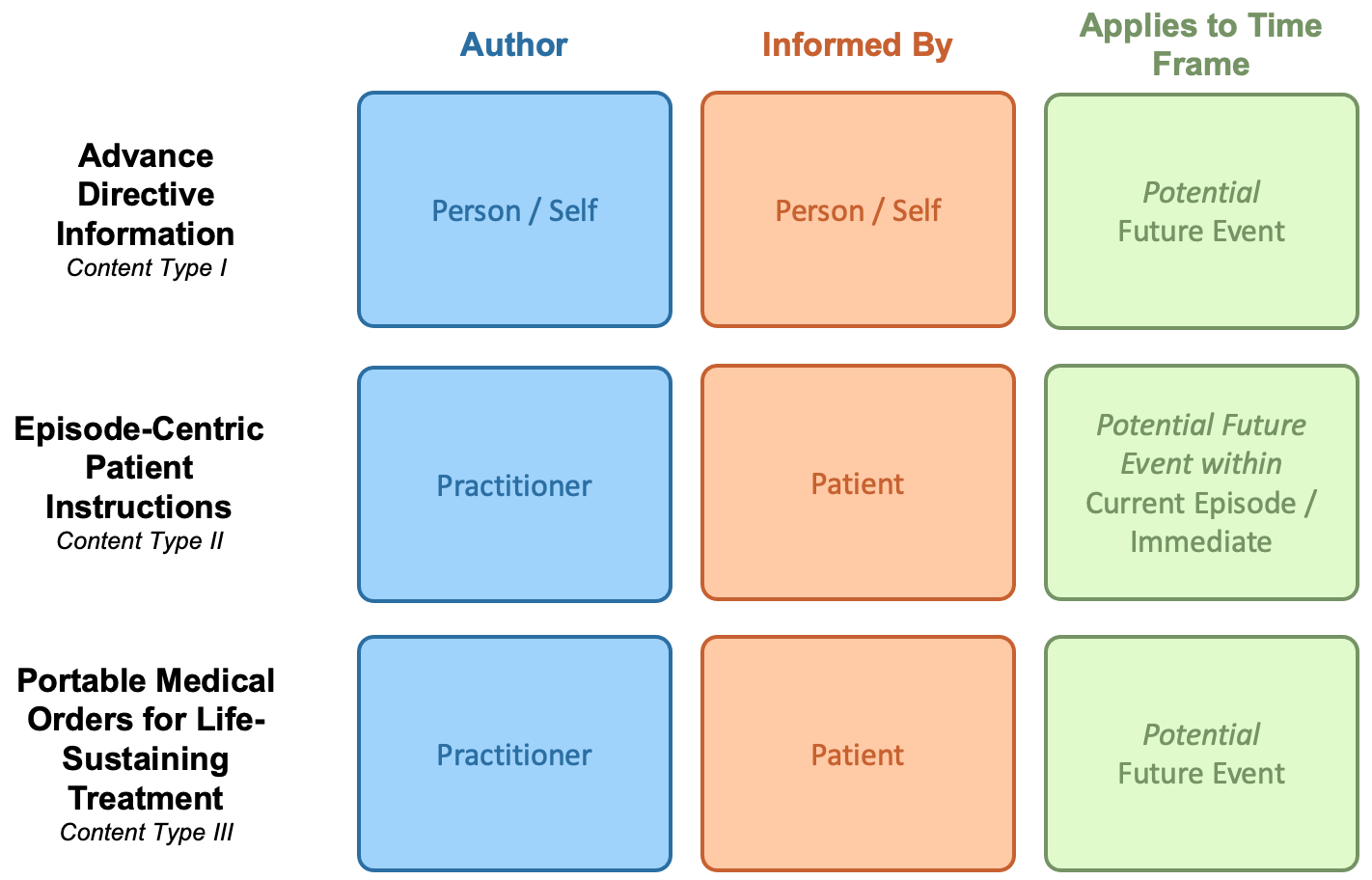PACIO Advance Healthcare Directive Interoperability Implementation Guide, published by HL7 International / Patient Empowerment. This guide is not an authorized publication; it is the continuous build for version 2.0.0-ballot built by the FHIR (HL7® FHIR® Standard) CI Build. This version is based on the current content of https://github.com/HL7/fhir-pacio-adi/ and changes regularly. See the Directory of published versions
| Page standards status: Informative |
This section provides additional guidance on the relationship between the associated profiles and the structure of the interoperable advance healthcare directive documents defined in this IG.
There is a very important distinction for the three types of ADI content that will be covered in this IG. Below is a description of each type of content that will be covered by the ADI FHIR IG with versions.
Person-Authored Advance Directive Documents |
||
|---|---|---|
|
||
Encounter-Centric Instructions |
||
|
||
Provider-Authored Portable Medical Orders for Life-Sustaining Treatments |
||
|
||

The current version, STU2, of this ADI with FHIR IG covers the use of RESTful API interactions for creation, sharing, query/access, and verification of advance directive information between systems. This IG is not intended to cover medical intervention goals, preferences, priorities for individuals who are not able to create and document their own advance healthcare decisions.
STU2 supports only Person-Authored Advance Directives and PMO documents. Future versions of this FHIR IG will address encounter-centric patient instructions, Content Type 2.
Advance healthcare decision documents may take several forms, including scanned PDF documents, CDA documents, other binary documents, as well as native FHIR documents (using the Composition and other ADI-specific profiled FHIR resources). This guide defines the interoperable guidance necessary to support creation, update, query, and access to all of these types and other potential ADI document types (through encoding in a Binary resource). Today, most of these documents are shared through scanned images housed in EMRs, EHRs and other systems.
This implementation guide is designed to guide a range of digitization levels, ranging from scanned documents to fully discrete FHIR documents. These different types of ADI data can be more digitized than others within same document by its representation as a FHIR Composition resource. This is described in more detail in the ADI FHIR Document Structure section.
The diagram below further illustrates how these documents are organized. The FHIR DocumentReference resource is used for "indexing" of documents, similar to the way a library uses a card catalog to index books based on different search criteria, for example, by title, author, date, or classification code. The DocumentReference can be used in the same way for searching and finding documents with specific attributes such as type of document, subject (e.g., patient), author, dates. These attributes are provided in the metadata of the DocumentReference so that the actual documents do not have to be accessed for most common searches. A complete list of search capabilities on DocumentReference can be found in the Search Parameters section.
Digital signatures are defined as optional in this guide, for a myriad of factors including maturity of systems that can create and exchange digital ADI. If supported by a Content Creator or Document Registry Server system, the digital signature “authenticity information” will be captured in a Binary resource that is referenced by an additional DocumentReference resource where the relatesTo relationship of the “signature page” to the source document is “signs”.
There is movement within the FHIR community to begin using the Provenance resource as a standard way to capture the digital signature of a document. The signature within the Provenance resource would be used hold the digital signature authenticity information associated with a document, not an additional DocumentReference. As the DocumentReference resource begins to be used for many different types of documents, it may be more effective to keep signature pages in the Provenance Resource. A future version of the implementation guide will be updated to follow the standard FHIR guidance on signatures when it is finalized.
There is movement within the FHIR community to move towards using the Provenance resource as a standard way to apply a digital signature to a document in FHIR. The signature within the Provenance resource would be used to encrypt the binary (the actual document itself), not the DocumentReference. A future version of the implementation guide will be updated to follow the standard FHIR guidance on signatures when it is finalized.
ADI native documents using FHIR are instances of the Bundle resource with the type = document. The document should have all content contained within the Bundle with no external references except for the references to external documents in the DocumentationObservation through the focus data element. FHIR Bundle documents consist of multiple entry resources within it, with the first entry being a Composition resource. The Composition resource acts as the header and organizational construct. It contains information about the document such as the category of document, dates, and references to the various participants of the document, as well as document sections used to categorize or organize the contained entries.
This structure at the highest level is common to all ADI document types. Additional FHIR representation requirements will depend on:
Reference the IG section, Advance Directive Structure Requirements, for further guidance.
ADI documents should have a time period whereby the patient preferences or the PMOs are legally valid. These are indicated by expiration dates within the Person-Authored Composition and PMO Composition profiles as such:
Composition.dateComposition:extension:ExpirationDateExtensionAdvance directive documents often contain additional information, or clauses, related to specific areas of the document. This may include things like additional observations about which named healthcare agent is to be primary versus back-up, or a healthcare agent has been selected, or a statement by the author of the document that is felt to be important to the overall contents, and other information that provides context to the data otherwise expressed in the sections or entries of an ADI document. To support this information this guide has defined a Clause extension to all of the Composition sections and various profiles and elements.